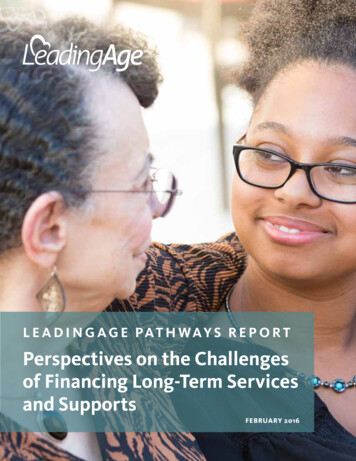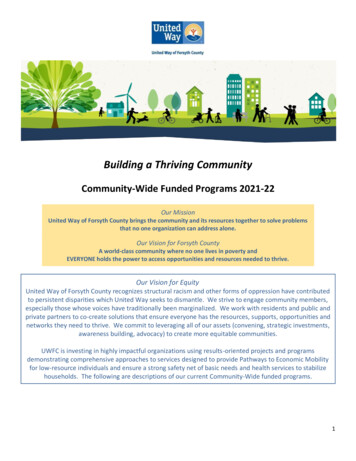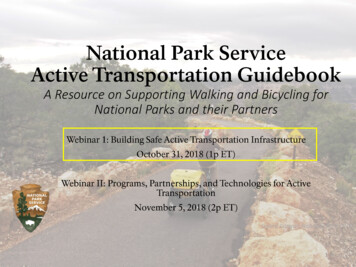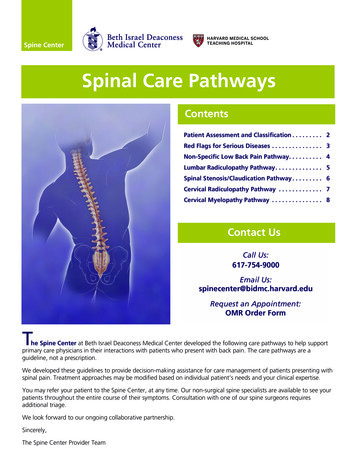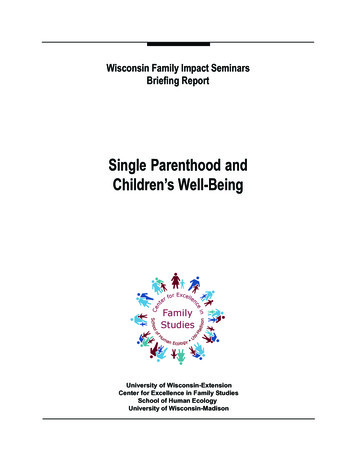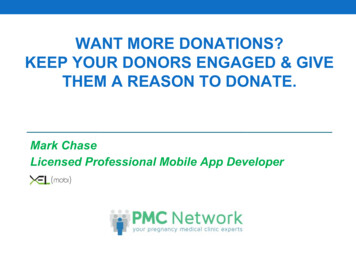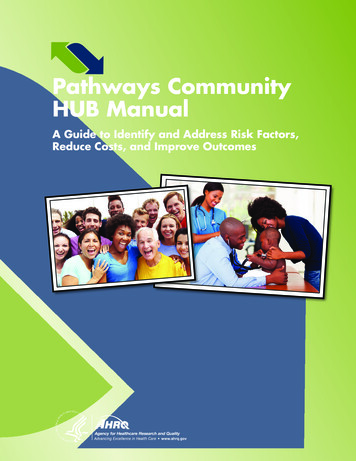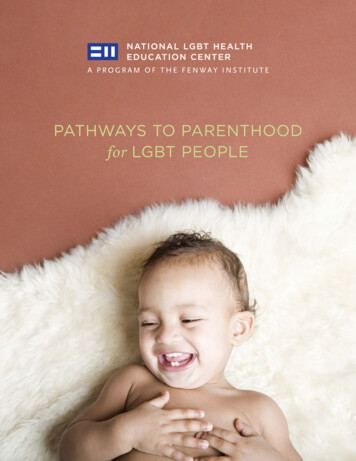
Transcription
PATHWAYS TO PARENTHOODfor LGBT PEOPLE
As more LGBT individuals and couples seek to have children, manywill turn to their health care providers for resources and guidance onwhat to do. It is therefore important for providers in health centers andother health care organizations to understand the various pathways toparenthood for LGBT people, as well as the unique issues they face asthey consider their options. Below we offer an overview of several optionsavailable to LGBT people interested in becoming parents and encouragehealth care providers to use this information as a baseline from which tohave a tailored, patient-driven conversation.3Pathways to Parenthood for LGBT PeopleA GROWING NUMBER OF lesbian, gay, bisexual, and transgender(LGBT) people are starting families. The 2010 US Census reported thatapproximately 19% of same-sex couples are currently raising children, anda 2013 Pew Research national survey found that 51% of LGBT adults of anyage have children or would like to have children in the future.1 With thechanges in marriage laws across the country, LGBT individuals and coupleswho may have once been on the fence about parenthood may now feeleven more encouraged to start families.2
Pathways to Parenthood for LGBT People4Adoption & Foster ParentingThe number of same-sex couples adopting children in the United States increasedover 10% between the years 2000 to 2009. According to U.S. Census data, LGB parentsare 4.5 times more likely to be raising adopted children than heterosexual parents.3 Inaddition, approximately 2,600 same-sex couples are raising foster children; they are sixtimes more likely to be raising foster children than heterosexual couples.4
CLINICAL CASE VIGNETTE Duringhis annual visit with his primary careprovider, Lionel mentions that he and his partner, Trevor, desireto become parents. Neither feels a strong desire to be biologicallyconnected to a child. Lionel would like to learn more aboutfostering and adoption. What information can be shared withLionel, and what issues do he and Trevor need to consider?Private agencies are regulated by the state andare often non-profit organizations. Privatelyowned and operated agencies sometimeshave stated or unstated preferences thatdisadvantage LGBT adoptive parents, whileothers specifically focus on helping LGBTfamilies. Private agencies charge a fee, whichoften include the provision of support servicesfor adoptive parents.Open or Closed AdoptionIn an open adoption, the biological parent(s)and the adoptive parent(s) are known to eachother and agree on the degree of contactbetween the adoptive child and the biologicalparent(s). In a closed adoption, the identity ofthe biological parent(s) is withheld from theadoptive parent(s) and from the adoptive child.Joint Adoption or Second-Parent AdoptionIn a joint adoption, both partners jointlypetition to adopt a child simultaneously. Jointadoptions are for couples, such as Lionel andTrevor, who desire to adopt a child together.In cases where joint adoption is not an option,for example in a jurisdiction that prohibitsunmarried or same-sex couples to jointly adopt,one partner in a couple (e.g., Lionel) couldindividually adopt the child. The other partner(e.g., Trevor) could then petition to adopt thechild through second-parent adoption, alsoknown as co-parent adoption. Second parentadoption allows a second parent to adopta child without the first parent losing anyparental rights; it also protects the couple’sparental rights regardless of where the familymoves or travels.5Pathways to Parenthood for LGBT PeoplePublic or Private AgenciesIf seeking to adopt, Lionel and Trevor willneed to consider whether to use a public orprivate agency. Public agencies are owned and/or funded by governmental sources for fostercare and adoption. Laws and policies regardingthe ability for LGBT individuals and samesex couples to adopt or foster have yet to beuniformly applied across all states. It is best tofamiliarize yourself with the specific policiesof your state in order to better understand yourpatients’ circumstances.
Other Issues to Consider Most countries prohibit adoptions by lesbianand gay people, making international adoptionrarely an option for those who reveal theirsexual orientation, including married same-sexcouples.5 Adoptions may take 12-36 months for matchingbetween adoptive parents and child and anadditional year for the termination of parentalrights of the birth parents and legal adoptionproceedings. However, once prospectiveparents have completed entry steps with an agency, the process of adopting a child can alsobe very quick.The steps for becoming a foster parent are verysimilar to those for adopting a child.6 Approximate Cost of Adoption7,8 Public domestic adoption: 2,000 Second-Parent adoption: 2,000 Private domestic adoption: 20,000-35,000 Private international adoption: 25,000-50,000
Pathways to Parenthood for LGBT People7Assisted Reproduction: Donor Insemination & IVFDonor insemination (sometimes referred to as alternative or artificial insemination)is when sperm is injected into the cervix or uterus in order to fertilize an egg. In vitrofertilization, or IVF, is when an egg is inseminated in a laboratory and thenimplanted into the uterus.
CLINICAL CASE VIGNETTE Kendraand her wife Maria make anappointment with the obstetrics and gynecology departmentat their health center because they desire to have biologicalchildren but are unsure how to proceed. How can Kendra andMaria’s OB-GYN counsel them about having biological children?What are the potential issues they need to consider?Pathways to Parenthood for LGBT People8Known or Unknown Sperm DonorA known sperm donor is a friend, acquaintance,or relative of the prospective parents. A knowndonor allows for the possibility that the donorcan become involved in the child’s life (ifdesired). When using a known donor, parentsare advised to have a formal legal agreementwhich typically has the donor waive parentalrights; however, some states do not recognizesuch agreements. An unknown sperm donor,whereby a sperm bank connects prospectiveparents with anonymous sperm donors,generally avoids paternity claims. Most spermbanks provide background information onanonymous sperm donors, such as ethnicity,interests, education, and family medical history,and follow strict medical screening processes.Insemination and Carrying the PregnancyInseminations can be performed in a clinicalsetting by medical practitioners or at homewith a kit and instructions. Couples need todecide who will be inseminated and carry thepregnancy. Some couples decide to have twoor more children, with both partners eachcarrying a pregnancy. Others may choose“partner to partner” insemination, in whichone partner’s egg is inseminated through IVFand then implanted into the other partner’suterus. This allows both partners to have abiological connection to the child; however,the cost is much higher than with in vivodonor insemination. The parent who is notbiologically related to the child should considersecond parent adoption (see Adoption section),even if the couple is married.Cryopreservation and InseminationSome patients have frozen eggs, sperm, orembryos that they wish to use for insemination.This can be the case for transgender patients,and also for patients who underwent aprocedure known to affect fertility (such aschemotherapy). Transgender women (MTF)who have preserved sperm before medicaltransition can serve as the sperm donor indonor insemination; transgender men (FTM)who have preserved eggs can serve as the eggdonor through IVF. Transgender men who haveretained female reproductive organs may alsocarry a pregnancy, but should be advised tosuspend testosterone therapy prior to becomingpregnant. For both transgender men andwomen, using natal sex organs in pregnancycan raise some psychosocial issues,9 which aremanageable with affirmative care and support.Considerations for Transgender PregnancyMany transgender people undergo medical andsurgical procedures that can limit or preventtheir ability to reproduce or carry a pregnancy.It is therefore very important for providersto discuss future reproductive options andparental desires with transgender patientswho are preparing to start cross-sex hormonetherapy or to have surgery. This discussion caninclude ways in which different treatmentsaffect fertility and reproductive processes,as well as options to preserve sperm, eggs,or embryos prior to treatment.10 For moreinformation on fertility, reproduction, andpregnancy options for transgender people, seethe Resources section.
Approximate Cost of Donor Inseminationand IVF11,12 The costs associated with donorinsemination and IVF range from: 5,000 60,000. Donor insemination is much lessexpensive than IVF. Insurance typically only covers thesecosts for infertility, and some policies onlycover those who are trying to get pregnantthrough heterosexual sex. Thereforemost same-sex couples are excluded frominsurance coverage and must pay outof pocket. Costs associated with freezing eggs, sperm,and embryos vary greatly, and might not becovered by insurance. While the technologyof egg freezing and thawing is gettingbetter, frozen and thawed embryos have abetter chance of successfully implanting inthe uterus. However, for some patients thefreezing and use of embryos may bring upreligious or ethical concerns.Legal costs associated with known donorinsemination range from 750- 1500.
Pathways to Parenthood for LGBT People10Assisted Reproduction: SurrogacyA surrogacy arrangement is the carrying of a pregnancy for other intended parent(s).These arrangements are extremely expensive, highly regulated, and legally limited.Making these arrangements requires both identifying an egg donor and a surrogate.Both of these can be extensive processes.
CLINICAL CASE VIGNETTE Duringa routine visit, Rafael tells his primarycare provider that he and his husband Andrew desire to havea child. A close female friend has offered to act as a gestationalsurrogate. They have heard that surrogacy is challenging andexpensive, but they feel strongly about having a biologicalchild. What issues should Andrew and Rafael be aware of whenconsidering surrogacy?Known and Unknown Egg DonorsAs with sperm donors, couples can choose aknown or unknown egg donor. Similarly, it isrecommended that parents have the egg donorsign a legal agreement waiving their parentalrights. For an unknown egg donor, neither theegg donor nor the gestational surrogate mayhave a full legal claim to the child, which maybe desirable for reducing legal risks. Couplesmust decide which partner’s sperm to use inthe surrogacy.Approximate Cost of Surrogacy14,15 The costs typically associated withsurrogacy arrangements average between 80,000-140,000. Surrogates receivecompensation depending on factorsincluding the type of pregnancy and thenumber of previous pregnancies (surrogatemother experience) and for expenses suchas lost wages, medical co-pays, medicalinsurance, travel, and medications. There are also costs involved with thepurchase of eggs or sperm, egg harvesting,embryo transfer, and medical procedures. Legal costs can also be significant, and theintended parents often pay the surrogate’slegal costs.11Pathways to Parenthood for LGBT PeopleTraditional and Gestational SurrogatesA traditional surrogacy arrangement is whenthe same person donates the eggs and carriesthe child. A gestational surrogate is implantedwith a donated and fertilized egg and carriesthe child to term. Both types of surrogacyarrangements require extensive physical,emotional, and psychological tests and matchingand interviewing procedures for both theintended parents and the surrogate. Surrogacyagreements between the surrogate and intendedparents should be prepared by qualified legalcounsel; however, surrogacy is not legal orrecognized by courts in every state.13
Organizational Support for LGBT ParentsOn a system level, there are many ways that health centers and other health careorganizations can incorporate LGBT-affirming family planning services throughouttheir organization. For example, health centers can develop referral lists of local LGBTinclusive adoption agencies, sperm banks, cryobanks, obstetric practices, and legalservices. A health center may also consider adding insemination services in its practice,such as the Alternative Insemination Program at Fenway Health (see Resources). Holdingworkshops and support groups for LGBT parents and prospective parents is another wayfor a health center to proactively support LGBT families.
ConclusionWhen LGBT patients express a desire to start a family, clinicians should be prepared toadvise LGBT patients on their options as well as any unique medical issues that mightbe implicated, much as they would advise any other patients. If patients seek additionalsources of information, we encourage clinicians to refer patients to the resources identifiedin this publication and to research local resources as well. It is also important to providewelcoming and inclusive environments for LGBT patients so they are comfortable openingup about their relationship and familial desires. At times, the road to parenthood for LGBTpeople and same-sex couples can be difficult. It is important for clinicians, and the entirehealth center, to ensure that all of their patients have full access to the supports andresources needed to enjoy an expanding family.
ResourcesThere are many resources available from theNational LGBT Health Education Center,lgbthealtheducation.org, including thefollowing webinars:LGBT Families: Improving Access to BetterHealth CarePathways to Parenthood: Assisted Reproductionand AdoptionPathways to Parenthood for LGBT People16AdoptionHuman Rights Campaign has compiled manyresources on adoption in their AdoptionOverview – hrc.org/resources/topic/adoption –as well as questions to consider before adopting– g-the-adoption-processFamily Equality Council has informationby state for fostering, adoption, and secondparent adoption laws – familyequality.org/getinformed/equality maps/joint adoption lawsDonor InseminationFenway Health’s Alternative Inseminationprogram provides medical alternatives forachieving conception, as well as education,resources, support networks, and referrals– ionHuman Rights Campaign has a donoragreement resource for those using a knownsperm donor – hrc.org/resources/donoragreementSurrogacyHuman Rights Campaign has a resource aboutwhat to expect from surrogacy – hrc.org/resources/surrogacy-what-to-expectAmerican Bar Association Journal has anarticle about using an agency or doing ityourself – abajournal.com/magazine/article/as surrogacy becomes more popular legalproblems proliferateCreative Family Connections hassurrogacy information by state -state/f49jqTransgender Reproduction and PregnancyThe following articles provide moreinformation:Obedin-Maliver J, Makadon HJ. TransgenderMen and Pregnancy. Obstetric Medicine:The Medicine of Pregnancy. 2015.OnlineFirst, published on October 28,2015 as doi:10.1177/1753495X15612658.Available at: 5612658.full.pdf htmlT’Sjoen G, Van Caenegem E, WierckxK. Transgenderism and reproduction.Curr Opin Endocrinol Diabetes Obes.2013;20:575-9. Available at: ncbi.nlm.nih.gov/pubmed/24468761Welcoming EnvironmentThere are many publications from theNational LGBT Health Education Center’swebsite, lgbthealtheducation.org/publications,including:Ten Things: Creating Inclusive Health CareEnvironments for LGBT PeopleDo Ask, Do Tell: Talking to your provider aboutbeing LGBTTaking Routine Histories of Sexual Health: ASystem-Wide Approach for Health Centers
AcknowledgmentsWe would like to thank Feldesman Tucker Leifer Fidell, LLP for writing this publication incollaboration with the National LGBT Health Education Center, March 2016.ReferencesPew Research Center. A Survey of LGBTAmericans: Attitudes, Experiences andValues in Changing Times. Washington,D.C.: Pew Research Center; ricans 06-2013.pdf10. Hembree WC, Cohen-Kettenis P,Delemarre-van de Waal HA, Gooren LJ,Meyer, III WJ, Spack NP, Tangpricha V,Montori VM. Endocrine Treatment ofTranssexual Persons: An Endocrine SocietyPractical Guideline. 2013; 94(9):3132-3154.2.Khimm S. The New Nuclear Family. TheNew Republic. 2015 1. RESOLVE: The National InfertilityAssociation. The Costs of treatment.html3.Gates GJ. LGBT Parenting in the UnitedStates. The Williams Institute. nited-states4.Ibid.5.Levine S. Adoption Options Overview.Human Rights Campaign. hrc.org/resources/adoption-options-overview6.Adopt Us Kids. How to Foster. adoptuskids.org/for-families/how-to-foster7.Child Welfare Information Gateway. Costsof adopting. 2011. Washington, DC: U.S.Department of Health and Human Services,Children’s Bureau.8.Human Rights Campaign. How Much DoesAdoption Cost? s S, Wojnar D, Pettinato M. Conception,Pregnancy, and Birth Experiences of Maleand Gender Variant Gestational Parents: It’sHow We Could Have a Family. J Midwifery& Women’s Health 2015; 60:62-69.12. Kane, L. How Much Does It Cost To DelayYour Biological Clock? Learnvest. -and-biological-clock13. Creative Family Connections. GestationalSurrogacy Law Across the UnitedStates. 2015. tate/f49jq14. Herron, J. The costs of adoption vs.surrogacy. Bankrate.com. 2013. vs-surrogacy.aspx15. Tucker, C. Surrogacy Costs: A Guide ForIntended Parents. Law Office of CatherineTucker. 2014. tuckerlegal.com/surrogacycosts17Pathways to Parenthood for LGBT People1.
Pathways to Parenthood for LGBT People18This publication is designed to provide accurate and authoritative information in regard to the subjectmatter covered. It is published with the understanding that the publisher is not engaged in renderinglegal, financial, or other professional service. If legal advice or other expert advice is required, theservices of a competent professional should be sought.This project was supported by the Health Resources and Services Administration (HRSA) of theU.S. Department of Health and Human Services (HHS) under cooperative agreement numberU30CS22742, Training and Technical Assistance National Cooperative Agreements (NCAs) for 449,985.00 with 0% of the total NCA project financed with non-federal sources. This information orcontent and conclusions are those of the author and should not be construed as the official position orpolicy of, nor should any endorsements be inferred by HRSA, HHS, or the U.S. Government.COM-2852
te l617.927.6354we blgbthealtheducation.orgthe fenway 1340 Boylston Street, Boston, MA 02215
CLINICAL CASE VIGNETTE During a routine visit, Rafael tells his primary care provider that he and his husband Andrew desire to have a child. A close female friend has offered to act as a gestational surrogate. They have heard that surrogacy is challenging and expensive, but they feel strongly about having a biological child.

